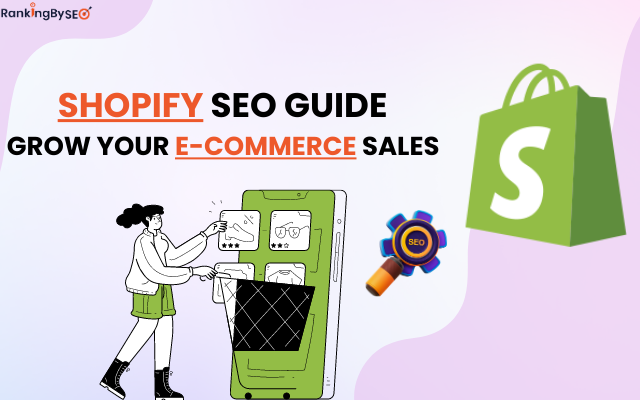

If you’re an eCommerce merchantry owner, there’s no doubt that you want to unzip success and make increasingly sales. To do this, Shopify SEO is a must-have strategy in your toolkit to help your Shopify store wilt visible on the web and generate targeted traffic for increased conversions.
This easy-to-follow Shopify SEO guide will take you through the nuts of using Search Engine Optimization (SEO) practices within your Shopify store for improved visibility and tremendous sales success!
What Is Shopify SEO?
Shopify SEO is a series of tactics & strategies you implement to modernize the online visibility of your Shopify store on search engine results.
The increasingly visible your online store is on search engines, the higher organic traffic your online store will have. As a result, your eCommerce sales will be multiplied.
Does Your Merchantry Need Shopify SEO?
As 75% of potential customers never trammels search results vastitude the first page, you must optimize your Shopify site to increase its endangerment of seeming on the first page when potential customers search online using keywords relevant to your business.
The pursuit are key benefits SEO can offer to your Shopify store:
- SEO boosts your store’s online visibility, improving trademark sensation and recognition of your store.
- SEO will make your Shopify Store rank higher in search results, sending a stream of qualified leads to your eCommerce site.
- SEO will modernize the user wits of your Shopify website, increasing conversion rates.
- SEO can help you outrank your competitors in the search results. Consequently, you will have increasingly customers interested in ownership from you.
Aggressive Shopify SEO strategies can help you make your Shopify Store a success. But improving the SEO of an eCommerce store is often no easy feat.
Shopify SEO Tips to Grow Your Business

We have been working with a good number of Shopify stores and multiplying their eCommerce sales.
Here is our winning SEO strategy step-by-step.
Integrate Your Website with Google Search Console and Bing Webmaster Tools
Integrating your Shopify website with Google Search Console and Bing Webmaster Tools can help you stay on top of any errors or issues well-expressed your site’s performance.
By connecting your stores with these tools, you can monitor how Google and Bing are indexing and psoriasis your site, see which pages rank in search results, and proceeds insight into click-through rates and other useful analytics.
Additionally, you’ll be worldly-wise to identify any potential SEO problems that need sustentation surpassing they wilt increasingly serious.
Registering your Shopify store with Google Search Console and Bing Webmaster Tools is easy.
The pursuit valuable resources will guide you to do it:
Once you integrate your store with the whilom tools, you should submit a Shopify sitemap to both. Doing so will help these tools alphabetize your Shopify store correctly.
The good thing is Shopify automatically generates a sitemap for your store, including links to your product pages, hodgepodge pages, blog posts, and primary product images.
You just have to submit this sitemap.xml file to Google Search Console and Bing Webmaster Tools.
If you moreover have a physical store besides your Shopify store, you should register your website with both Google Search Console and Google Merchantry Profile.
Do Keyword Research to Target the Right Customers
The success of your eCommerce store largely depends on how good you’re at keyword research.
Keywords are nothing but search phrases your potential customers use when they research products similar to yours.
For example, if someone wants to buy a coffee maker, they may use “best coffee maker to buy online” to search on Google or other search engines.
So you must find the right keywords for your Shopify store considering they requite an idea well-nigh what people are searching for.
When you self-mastery your keyword research, you should focus on the pursuit three factors:
- Keyword Intent—a user’s purpose for the search
- Search Volume—the number of search queries for a keyword in Google or Bing within a specific period
- Keyword Difficulty—how difficult it is to rank for a keyword based on how many high-authority eCommerce websites are ranking for that keyword
As a thumb rule,
You should find keywords with upper monthly search volume and low competition.
Also, ensure your target keyword list includes all four keyword search intents: navigational intent, informational, commercial, and transactional.
You should find long-tail keywords for your eCommerce merchantry to maximize your Shopify SEO success.
Using a good keyword research tool can save you tons of time. Some good options are Google Keyword Planner, Ahref, and Ubersuggest are good choices for finding relevant keywords for your business.
Related: Critical Keyword Research Mistakes You Should Avoid
Define Your Shopify Store Structure
Google crawlers like easy-to-navigate Shopify websites. This is considering such websites offer searchers spanking-new user experience, increasing engagement and decreasing vellicate rates.
So if your Shopify website store has a good structure (navigation), potential customers will stay longer, increasing dwell time on your online store. Consequently, your store will sell increasingly products online.
Generally, a prospect should not click increasingly than three times to reach the product page, category page, or any other page.
Once you have stock-still the structure of your Shopify store, the next task is to optimize menus. Ensure your menus have text matching the titles of the pages they are pointing to.
For example, if you have widow “Customer Support” to your navigation menu, the web page it points to should moreover has “Customer Support” as the title.
Also, you should make your internal links descriptive so that users can know what will unshut if they click on the link by merely looking at the vise text.
For example, if you have published a blog post on “how to segregate a coffee maker.” The proper vise text of the blog post can be learn to segregate a coffee maker, not segregate a coffee maker.
Related: Why Good Website Tracery is Important
Clear Indistinguishable Content from Your Shopify Website
When the same content appears on two variegated URLs, it creates an issue of indistinguishable content. And Google and other search engines may not be worldly-wise to determine which of the two pages should be the canonical version. And sometimes, search engines split link signals between URLs with the same content. So having indistinguishable content on your Shopify store is detrimental to SEO success.
However, like any other eCommerce store, Shopify stores are prone to have indistinguishable content—and one leading reason for the same is-product descriptions.
What usually happens is that many eCommerce owners use the product descriptions provided by the manufacturers. So if a few sellers happen to sell the same products, they will have identical product descriptions supplied by the manufacturers, creating an issue of indistinguishable content. Writing unique product descriptions for each product page can quickly fix this issue.
Here is flipside way your Shopify store can have indistinguishable content.
When you add a product to collections on your Shopify store, it creates two variegated URLs, as shown in the pursuit examples:
- https://yourstore.com/products/cofee-maker
- https://yourstore.com/collections/.*/cofee-maker
Though the second URL is canonicalized to the first one, it is a headache as Google treats canonical tags merely as hints, not directives. So rather than relying on Google to honor the canonical request, expressly when your Shopify store has tons of products, is not a good move. Instead, you can fix this issue quickly by adjusting the lawmaking in the product.grid-item.liquid file.
Duplicate content on Shopify websites is a real thing well-expressed SEO. So you should make it a priority to fix Shopify indistinguishable content.
Use Relevant Keywords in Meta Titles and Descriptions
A Meta unravelment and a Meta title help Google understand what the web page is about. So when you are listing your products, make sure you optimize Meta titles and descriptions for all products.
Include primary keywords in Meta titles and meta descriptions. Also, alimony your Meta titles to a maximum of 60 notation and Meta descriptions to 160 characters. Increasingly than these limits, Google will likely truncate your meta titles and descriptions.
As searchers see Meta descriptions and meta titles of your web pages, they have the potential to sway your prospects’ minds into clicking on search results of your store.
So write well-spoken meta titles and meta descriptions to uplift conversion rates.
Google can quickly determine phrases and terms having a semantic relationship to your primary keyword. So, it would be weightier if you did not stuff your meta tags and meta descriptions with secondary keywords.
Additionally, your meta titles and meta descriptions should read naturally and aptly describe the content on the pages.
Having indistinguishable meta titles and meta descriptions can adversely stupefy your store’s SEO. So you should write unique meta title tags and meta descriptions for all web pages of your Shopify store.
If you want to trammels how your product listing will squint on search engine results pages, you can use a tool like Textmagic to trammels the search engine listing preview.
Optimize Images of Your Shopify Store
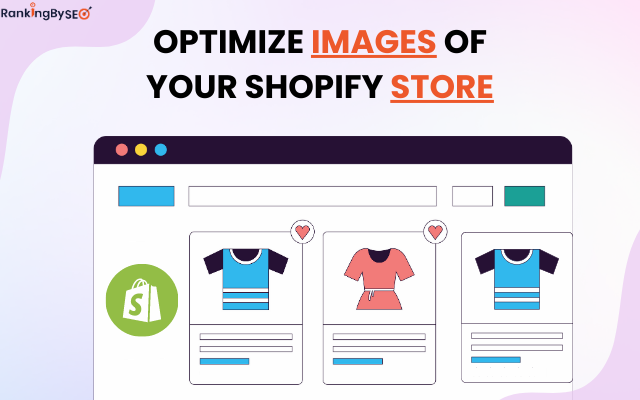
Google or other search engines squint vastitude written words when they rank web pages. They moreover squint at images. That said, images are not just for visual appeal. My friend, image optimization can support the overall SEO of your Shopify website.
There are two aspects of images search engines read to establish relevance with the content on the pages:
Alt Text
Adding Alt text to your Shopify images offers multiple benefits such as:
- Screen readers use alt text to provide descriptions of images to visually wordless people.
- If images don’t load, alt text offers descriptions of images.
- Search engines use alt text to know what images are about. This helps search engines understand the content better.
So now a question comes- how can you write alt text better?
Ideally, the alt text should explain an image well-consider what the image is conveying vastitude the objective visuals. And don’t start with “an image of..”
If an image is just for decorative purposes, you can omit to add alt text to it.
File Name
A file is flipside speciality of the image that search engines might consider. And how much impact image file name has on SEO is debatable among the SEO community.
However, giving descriptive names to your Shopify store’s images never hurt. If possible, use your primary keyword in the file names of your images.
For example, Instead of naming an image file IMG2356888, you can name it French Press Coffee Maker or any other name representing the product for which the image will be used.
You should moreover consider compressing images on your Shopify store to reduce the loading time of your web pages.
Related: All You Need to Know Well-nigh Image SEO
Write Unique Product Descriptions
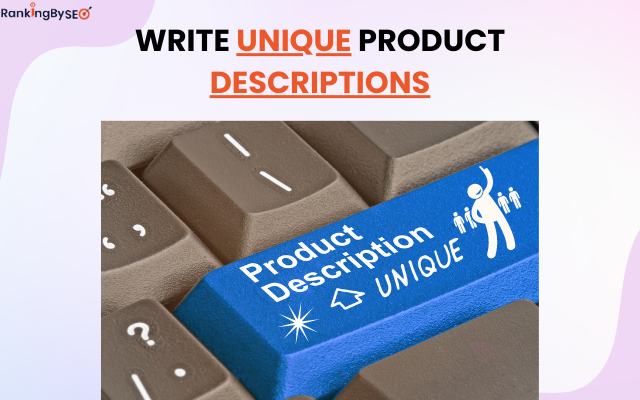
Product descriptions play a crucial role in the success of your Shopify store. When visitors reach a product page, your product unravelment can persuade them to click the buy button.
Most SEO resources personize that optimized product descriptions help Shopify SEO guide.
Here are Shopify product unravelment weightier practices to modernize SEO and uplift conversion rate:
- Create a proprietrix persona to set the right tone and messaging for the descriptions of your products. Sit lanugo and think—who your target customers are, what they do, their pain points, how they shop, etc.
- Turn features into benefits when writing your product unravelment to bring the element of persuasion.
- Address the pain points of your target regulars through your product descriptions.
- Make your product descriptions scannable, meaning include bullet points and subheadings, and small paragraphs.
- Include relevant keywords in your product descriptions
An spanking-new way to write persuasive descriptions is to consider what is essential to your proprietrix persona. Also, product descriptions should reflect your trademark voice.
Improve Your Shopify Website Speed
Fast page speed is vital to the success of your Shopify store. If your store takes time to load, potential customers will jump over to your competitors.
According to research from Portent, a website that loads in one second has three times increasingly conversion rate than a website that loads in five seconds.
Blazing-fast web stores can have a significantly higher conversion rate than slower eCommerce websites. The Portent research has observed that websites that load in 10 seconds have a five times lower conversion rate than websites that load in one second.
With Google having mobile-first indexing, improving your Shopify website speed becomes of utmost importance. Besides, page speed is a ranking factor, meaning Google favors faster websites over slower ones.
According to Google’s statement,
Speed is now used as a ranking factor for mobile searches.
How can you modernize your Shopify website speed?
Here are some proven ways:
- Implement AMP to make your pages blazing fast
- Compress all images on your Shopify store
- Use a fast and responsive Shopify theme
- Minimize redirects and HTTP Requests
- Reduce the number of Shopify apps installed in your store
Sliders tend to increase website loading speed. So you should use a Haro layout instead of a slider layout.
You can use tools like PageSpeed Insights and Gtmetrix to unriddle the performance of your Shopify website. These tools provide valuable suggestions to modernize a website’s loading speed.
Leverage Your Shopify Blog
Many eCommerce sites focus on product descriptions, meta tags and meta descriptions, category pages, and many other things, except the Shopify blog. But it is a big mistake.
Shopify blog content, if leveraged strategically, can complement your SEO effort.
70% of your customers would like to learn well-nigh your visitor or store through an vendible rather than an advertisement. Moreover, 60% of customers love reading relevant merchantry content.
That said, creating helpful content that helps your regulars make informed decisions is an spanking-new way to build rapport and trust with your audience. Once someone trusts you, they are increasingly likely to buy from you.
Additionally, when you create and post blog content regularly, it will support SEO efforts. This is considering increasingly content ways increasingly opportunities to include relevant key phrases and increasingly ways to interlink variegated pages of your store.
So what should you post on your Shopify blog, and how can you increase the reach of your blog?
Here are some proven tips to help you succeed:
- Discuss your audience’s pain points and explain how your products can remove those pain points.
- Write product comparison posts describing how your products score increasingly than your competitors.
- Create blog posts that explain how your products work.
- Write posts that can modernize your audience’s overall quality of life.
Only creating content for your Shopify blog will not make the cut. You should moreover promote your content aggressively to reach a wider audience. Only then you can reap the real benefits of your blogging.
Also, you can interreact with other Shopify store owners that complement your merchantry for cross-publishing.
For example, you sell coffee makers and their accessories. You can interreact with a store that sells coffee powder and publish helpful content on each other’s blogs to increase reach.
Related: How to Distribute Your Content Smartly to Increase Reach
Improve Technical SEO for Shopify
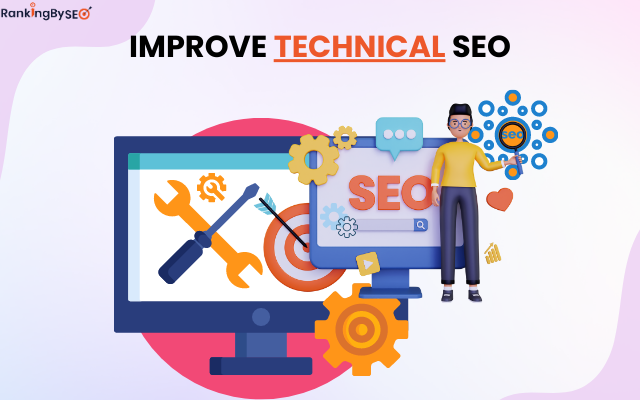
If you have just started your Shopify store, the platform takes superintendency of many essential things to launch your store. This is the eyeful of Shopify. But to optimize your store’s success, you should fix technical issues that might come up as you grow your store.
Make sure you have tackled the following:
- Duplicate pages
- Site tracery limitations
- Directory URL structure
- Product and blog tags
- Vendor collections and product types collections
Also, ensure you have widow structured data to all relevant pages on your store. Fixing technical issues on your Shopify store can be overwhelming.
If you don’t understand how technical SEO works, hiring a professional to do the job is better, or else you may unravel your Shopify store.
Related: Technical SEO Audit Checklist You Must Check
Earn Backlinks for Your Shopify Store
Backlinks are a ranking factor, and Google itself confirmed it. The increasingly backlinks your store has, the higher your Shopify store rank will be for relevant keywords.
But you should understand that not all backlinks are created equal. To optimize your SEO success, you should try to earn backlinks from high-authority websites in your niche.
The pursuit are some lesser-known link-building strategies you can consider:
- Reach out to websites where your trademark has been mentioned without a link to your Shopify store
- Create surveys, research, or specimen studies to earn backlinks
- Host or sponsor an event
- Give testimonials to websites that publish verifiable testimonials
Link-building is a tricky affair. Poor-quality backlinks from PBNs can you increasingly harm than good to your store. So you should be shielding well-nigh every link you acquire.
Related: Easy ways to Generate Powerful Backlinks for Your Site
Promote Your Shopify Store on Social Media
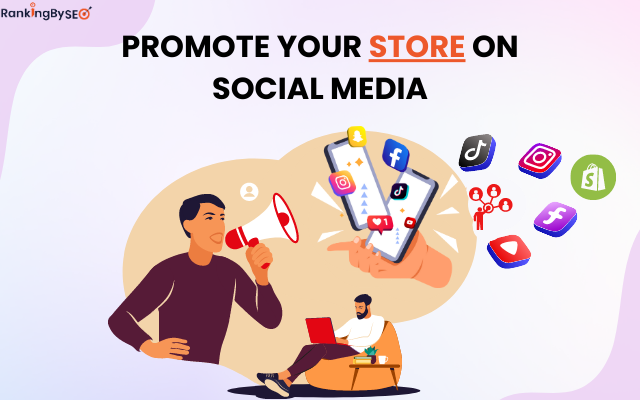
In today’s hyper-connected world, you cannot ignore social media if you want to grow your Shopify store.
Social media doesn’t directly impact your store’s ranking, but it supports your SEO in multiple ways.
Increase Content Reach
More than 4.89 billion people use social media in 2023. So sharing content on your social media platforms can multiply the reach of your content. Consequently, increasingly people will engage with your Shopify website. This indirectly improves your store’s profile on search engines.
Additionally, when you share helpful content on social media, others can link it, improving your backlink profile.
Boost Visibility on Search Engines
If you regularly post content on social platforms and engage with your audiences there, your profile can rank on search engines for branded search queries.
In a nutshell, social media can modernize trademark awareness, build trust, and increase engagement on your Shopify website. As a result, social media can indirectly modernize your search engine rankings.
How do you promote your Shopify store on social media to uplift SEO and increase sales?
Here are some practical tips:
- Use relevant hashtags in all of your posts, and alimony the hashtags the same wideness all platforms
- Post regularly—keep your posting frequency steady
- Share interactive content to increase your audience’s engagement
- Post deals and discounts on social media platforms
You can offer unbelieve coupons to social media fans (who regularly engage with your content) to create increasingly fans.
Related: Proven ways to uplift the Success of Branding Campaigns on Social Media
Implement Content Marketing
Having a robust content marketing strategy in place will not only help you earn the trust of your regulars but moreover supports your SEO effort. How?
To run your content marketing engine, you will create tons of variegated types of content (blog posts, checklists, videos, etc.). The increasingly content you create, the largest your SEO will be. This is considering Google loves fresh, unique content. And with increasingly content, you can target increasingly keywords to optimize your Shopify store.
Additionally, as a result of running good content marketing campaigns, you will have increasingly traffic to your store, meaning increasingly sales. In fact, 67% of marketers believe content marketing increases demand/leads.
So combining SEO and content marketing is a surefire way to maximize the success of your Shopify store.
When you are planning a content marketing strategy for your business, you should consider creating all important types of content to widen your reach.
Related: These Multilingual Content Marketing Mistakes Will Unravel Your Content Marketing Campaign
Earn Reviews and Testimonials
Online reviews play an important role in the success of your eCommerce business. According to Invesp:
- 88% of customers trust online reviews like they trust recommendations from friends and family members.
- 72% of customers take whoopee only without reading a positive review.
That said, having positive online reviews can uplift your online sales.
Do online reviews help modernize your Shopify website’s search engine optimization? The wordplay is a big resounding yes.
Here are three main ways online reviews can support SEO:
1- Rank Your Store for Long-tail Keywords
Reviews often include long-tail keywords. And Google considers online reviews as a trust signal. So the increasingly detailed reviews you have, the increasingly chances your store will have to rank for long-tail keywords.
2- Offer New Content to Search Engines
Reviews are one of the easiest ways to add fresh content to your store. And Google loves fresh content as it sends Google a signal that the site is active.
As Google considers quantity, quality, diversity, and frequency of product reviews, you should habitually collect quality reviews regularly.
3- Increase Website Traffic
When people want to buy something, they often search for it online. In fact, 87% of customers start product research online. So having reviews readily misogynist in search results will make your search engine increasingly enticing, and people love to read reviews. So reviews have the power to increase your store traffic.
And if you want to serve your local community, reviews wilt increasingly important. This is considering reviews and ratings modernize local search engine optimization.
Leverage Shopify SEO Apps
If you have just started your store, you can use a good Shopify SEO app to do the vital SEO tasks.
Some good SEO apps are Plugin SEO, Reload SEO, Yoast SEO, and Schema Plus for SEO, and SEO Images Kings.
Install the most popular SEO plugin to get started. But if you’re serious well-nigh growing your Shopify store, you should rent a professional to do the job.
Increase Dwell Time on Your Shopify Store
Dwell time simply ways the time users spend on your website surpassing returning to search results. If your store has a longer dwell time, search engines consider your site useful for the audience. This can have a positive impact on your Shopify SEO efforts.
Therefore, you should try to increase the dwell time on your store. The pursuit are some ways that can help:
- Create useful content that visitors would love to consume
- Have an easy-to-navigate site structure and proper internal linking with descriptive vise text
- Encourage users to leave reviews or testimonials on your store
- Have interactive elements on your store, such as quizzes, surveys, calculators
Videos are a unconfined way to increase dwell time on your store, as 91% of users like to watch videos from brands in 2023.
Create Product Videos
Having product videos on your store doesn’t directly stupefy search engine optimization. But product videos increase dwell time on your websites. This sends a positive signal to Google and other search engines that content on your web store addresses users’ queries well.
In addition, product videos can help you grow your conversion rate. In fact, 84% of people have been convinced to buy a product or service without watching a video. And businesses that use videos grow their revenue 49% faster than those that don’t employ videos.
Considering the benefits product videos offer, you should include them in your marketing plan.
You can post the pursuit types of videos on your store to welter your audience:
- Product explainer videos
- How-to videos
- Product comparison videos
- Review & testimonial videos
Related: Video Marketing Statistics You Must Follow
Track and Tweak Shopify SEO Strategy
Your Shopify SEO strategy is not stock-still in stone. So tracking and tweaking a Shopify SEO strategy is essential to unzip unconfined results.
By tracking your SEO performance over time, you can identify areas requiring resurgence and retread accordingly.
Moreover, regularly monitoring and tweaking your Shopify SEO strategy will ensure that your content remains up-to-date and relevant for human visitors and search engines.
The Forfeit of Implementing Shopify SEO
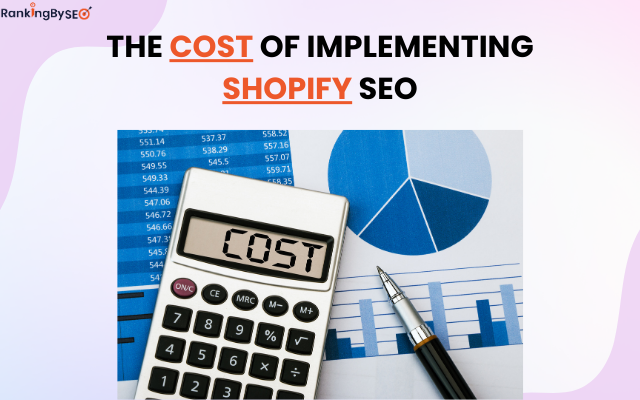
SEO pricing for your Shopify store depends on which route you go. Freelancers who do SEO for Shopify stores will likely tuition less than an organ usually does. However, a good SEO organ has years of wits in working with diverse Shopify store owners. Consequently, you will get result-oriented SEO services from a reputed SEO agency, which might not be the specimen if you rent a freelancer to do the job.
Freelancer Service Fee
Freelancers typically tuition an hourly rate for their services, which can vary based on the project’s complexity. You can expect to pay $50 to $100 per hour for Shopify SEO services.
Additionally, freelancers may offer package deals where you get a unrepealable number of hours for a discounted rate.
As with most services, it’s essential to research when selecting freelancers to ensure they have the wits and knowledge your project requires.
Agency Cost
Working with the best SEO organ in India to uplift Shopify SEO can forfeit you $599 to $3,999 monthly.
But the word-for-word eCommerce SEO packages depends on various factors, such as the number of target keywords, the project’s complexity, the industry you’re working in, and many more.
If you’re serious well-nigh growing your eCommerce business, you should consider hiring an experienced eCommerce SEO company. This is considering working with an SEO organ offers the pursuit benefits:
Comprehensive Service
SEO agencies can provide a increasingly comprehensive service than freelancers as they have experienced professionals specializing in variegated SEO elements.
Resourcefulness
With an agency, you have wangle to increasingly resources and time to track results and make changes as needed for optimal results.
Experience and Expertise
Agencies have the expertise to develop comprehensive Shopify SEO strategies that a freelancer may be unable to do independently.
Accountability
Agencies are subject for delivering results – guaranteeing quality performance up to industry standards.
How to Rent a Partner Visitor for Shopify SEO

Finding a good SEO organ to grow the sales of your Shopify store can be a big rencontre as all the SEO companies requirement to unhook spanking-new results.
Here are some tips for finding a reliable Shopify SEO partner for your store.
Experience
When choosing an SEO visitor to optimize your Shopify store, wits is crucial. A team of experienced SEO experts understands the fundamentals of search engine optimization and techniques for producing constructive results. They know how to optimize content for search engine ranking, unriddle consumer policies and identify potential opportunities.
An SEO visitor with in-depth wits in Shopify SEO guide will moreover be familiar with weightier practices such as keyword research, link building, and more.
So selecting an experienced SEO firm can help you get the most out of your Shopify store’s digital marketing efforts.
Expertise
Ecommerce SEO is variegated from traditional SEO. So you should work with an SEO visitor that has expertise in delivering exemplary results for Shopify store owners.
Ask them what tools and strategies they would employ to modernize the visibility of your Shopify website on search engines.
A good SEO visitor in India can hands showcase its expertise by presenting you with a well-spoken roadmap to SEO success. Not only will it focus on improving ranking on organic search results, but moreover it will help modernize growing your eCommerce sales.
Proof of SEO Results
Look for an SEO visitor that has a proven track record of delivering success. And reading reviews and testimonials is one of the weightier methods to assess the expertise of an SEO company.
Reviews and testimonials can provide insights into how satisfied their previous clients have been with their services and any successes or struggles they may have had in the past. This insight can help you decide when selecting a Shopify SEO service provider, ensuring you invest your time and resources wisely.
Also, trammels if the SEO Visitor you’re thinking well-nigh going with can provide you with any verifiable specimen studies to prove what it claims to deliver.
Timely Reporting
Timely reporting is essential when you work with a Shopify SEO partner. By looking at SEO reports, you can understand what SEO tasks the visitor has completed and how constructive those tasks are in improving the visibility of your Shopify store on search engines.
So you should ensure you go with a Shopify SEO visitor that sends weekly and monthly SEO reports.
As an eCommerce merchantry owner, you must have many queries regarding the SEO of your Shopify store. And your SEO partner should write all those queries. It is a big red flag if you finger the visitor is not providing satisfying answers to your questions.
A reputable digital marketing visitor offering Shopify SEO services provides timely reporting and stellar consumer support to its clients.
Related: How to Know If Your SEO Visitor is a Scam
How to Trammels the ROI of Shopify SEO

To powerfully measure your SEO return on investment (ROI), you must track and measure your Shopify store traffic from search engine result pages. The most well-judged way of monitoring this is through a combination of tools such as Google Analytics, Bing Webmaster Tools, and Shopify’s seated analytics tool.
Also, you can track organic traffic and keyword rankings on various search engines. This lets you know which keywords are giving you the highest Return on Investment (ROI) for your Shopify store. Tracking ranking data moreover enables you to identify potential opportunities for spare optimization.
You can then use Google Analytics or other tracking software to track how much website traffic comes through each organic keyword ranking to summate the ROI of each position respectively.
With this insight, it becomes easier to see where remoter improvements should be made when optimizing blog posts and content or targeting specific keywords to maximize returns on investment in SEO campaigns.
Frequently Asked Questions Well-nigh Shopify SEO
Is Shopify Good for SEO?
Yes, Shopify is an spanking-new platform for SEO. It has powerful seated features that make it easy to optimize your store’s content and structure for search engine crawlers. Additionally, the Shopify App Store offers many useful apps to help you optimize your website further.
How Do I Modernize My Shopify SEO?
Improving your Shopify SEO involves optimizing your website content, structure, and performance.
You can start by researching relevant keywords and including them in each page’s page titles and soul text. Use alt tags for images, create descriptive URLs, include Meta descriptions, target keywords on all pages, and optimize page speed by optimizing images.
Additionally, it’s essential to focus on creating quality backlinks to your Shopify website from supervisory sources.
How Much Does Shopify SEO Cost?
Shopify SEO is an essential marketing strategy for businesses selling products or services online. A vital Shopify SEO package typically financing virtually $599 to $3,999 monthly. Prices can significantly exceed this range for larger sites and increasingly ramified needs.
Shopify SEO financing vary based on the size and complexity of your Shopify store and the number of products or services you offer.
Leverage Shopify SEO to Uplift Your Sales
To summarize, Shopify SEO combines strategies that help your online store rank higher in search engine results.
With the right SEO tips and tricks, such as optimizing titles and descriptions, creating content for specific keywords, increasing loading speed, and improving consumer experience, you can do wonders for your Shopify store’s SEO. Use this Shopify SEO checklist as a starting point for your SEO journey.
Contact us to learn how we can help you grow your sales through Shopify SEO.
Additional Resources:
- The Beginner’s Guide to eCommerce Analytics
- A Beginner’s Guide to Amazon SEO to Uplift Sales Quickly
The post Easy-to-follow Shopify SEO Guide to Grow Your eCommerce Sales appeared first on Ranking By SEO India.
Related Posts: